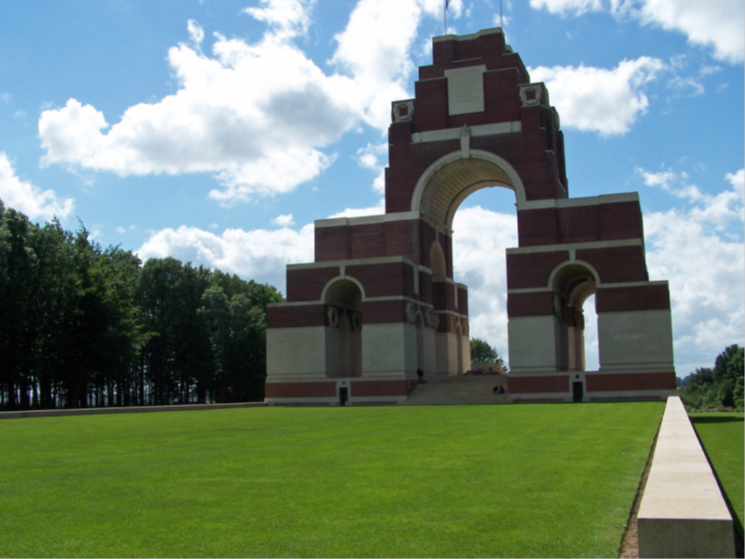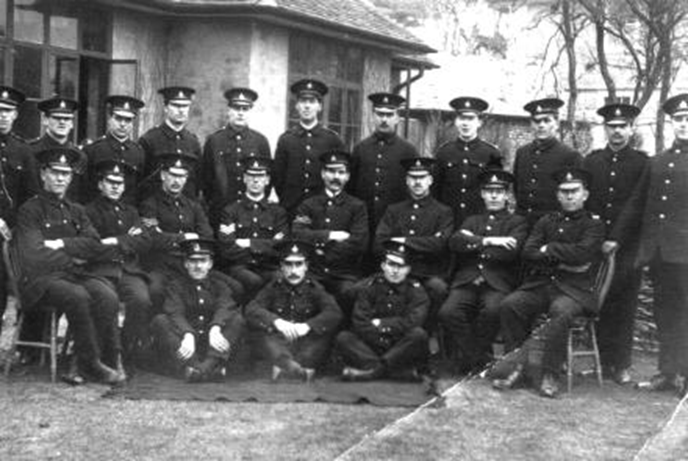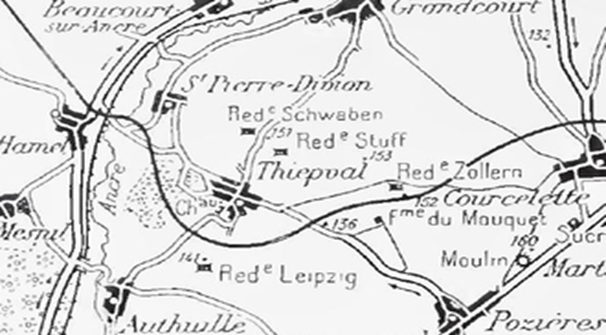FREDERICK ROBERT EDWARDS
Private, SD/2668, 13th Battalion, Royal Sussex Regiment
Killed in Action during the Battle of the Somme on 26 October 1916, aged about 18
Remembered with Honour on the Thiepval Memorial

Thiepval Memorial
(Click to enlarge)
Frederick Robert Edwards was born in 1898 in Hartfield, the son of John Edwards and Annie Edwards (née Card). At the time of the 1911 census, when he was 13, he lived at Holly Cottage, Chuck Hatch, and was attending school. His father was a carter on a farm in the area and his mother a charwoman. He had an elder brother, William John Edwards, 19, who was also a carter on a farm, and a sister Mary Edwards, aged 12. We cannot find a record of William John Edwards serving in the Great War.
Frederick joined up as a private in the 13th Battalion of the Royal Sussex Regiment. The 11th, 12th and 13th battalions of the regiment — the 'South Down' or 'pals' battalions — were raised and equipped by Lieutenant-Colonel Claude William Henry Lowther, Unionist MP for North Cumberland, who had acquired Herstmonceux castle in 1910, and they subsequently became known as "Lowther's Lambs". The battalions were formed at Cooden, Bexhill on 20 November 1914, where some 1,100 men enlisted in 56 hours. All original enlistments were given an "SD" (South Downs) prefix to their regimental number, and Frederick's number was SD/2668.
The regiment crossed to France via Southampton on 5-6 March 1916, landing at Le Havre. It served on the Western Front with 116th Brigade, 39th Division until the spring of 1918. The battles it was involved with during the Battles of the Somme included:
| 3 September | Fighting on the Ancre [Hamel] |
| 26-28 September | Battle of the Thiepval Ridge |
| 5 October-1 November | Battle of the Ancre Heights |
| 14 October | Capture of the Schwaben Redoubt |
| 21 October | Capture of Stuff Trench |
| 13-14 November | Battle of the Ancre |

The 11th Battalion, the Royal Sussex Regiment, at Cooden, Bexhill-on-Sea, October 1914
We cannot verify if Frederick is in this picture.
(Click to enlarge)
Photograph copyright ©Paul Reed.
The three 'pals' battalions of the Royal Sussex Regiment suffered terrible casualties on 30 June 1916, twenty-four hours before the much better known "First Day on the Somme". This was in a diversionary attack, a large scale raid launched by the 39th Division at a position called the Boar's Head, near Richebourg l'Avoué. Just under 1,100 casualties (dead, wounded and prisoners) were incurred in a fruitless attack that had no effect on the enemy's abilities to withstand the next day's assault on the Somme. The vast majority of the losses were to men from the county of Sussex. (Source: The Long Long Trail).
Frederick was killed in action on 26 October 1916. The 13th Battalion was involved in a major battle in October 2013. The battalion was serving at Redan Ridge on the Western Front, a ridge which played a significant role in the Somme Offensive of 1916.
Between 19 September and 3 October 1916 the 13th Battalion were posted to Redan Ridge (part of the Battle of the Somme) having relieved the 25th Royal Fusiliers. The time spent there involved frequent fighting with the Germans including shelling of gas on both sides. They were back there on 13 October to relieve the 12th Battalion, Royal Sussex Regiment. From 10 to 12 October the 13th Battalion were at Engelbelmer Wood where on the 11th a "Canteen started and proved a great success".
On 21 October his battalion moved up to the Schwaben Trench, where its headquarters were situated. The 8th Suffolks had captured Schwabengraben (Schwabian Trench) during the Battle of Thiepval Ridge (26-28 September).
Schwaben Redoubt had deep dug-outs for accommodation with multiple entrances, a battalion command post, first-aid post, signalling station and strong-points, with three heavy machine-guns and four light machine-guns. Many of the dug-outs were on the perimeter, at trench junctions (clockwise from north, using the English names): Irwin Trench (strong points 49 and 69), Lucky Way (strong point 27), Stuff Trench, Hessian Trench (strong point 45), Martin's Lane, the Strasburg Line (strong point 19) and Clay Trench (strong point 99). Inside the redoubt, along an inner trench on the south-west face, were strong-points 65, 37 and 39. Beyond the south-west face, in the maze of trenches towards Thiepval to the south and St. Pierre Division to the north-west, were nine more strong-points. The redoubt was triangular, with an extension to the east across the Thiepval-Grandcourt road and had a frontage of around 500 metres.

The capture of Thiepval and advance on Schwaben Redoubt, September-October 1916.
(Click to enlarge)
The battalion was involved in an attack on Stuff Trench on 21 October. They successfully captured and held the trench and a German attack on Schwaben Redoubt early on 21 October was repulsed. The majority of the fighting took place on 22 October around Stuff Trench. Both Bainbridge and Stuff Trench were heavily bombarded. Three officers were wounded in this fighting and 25 other ranks were killed, 71 wounded and 30 missing. After three days in the rear the battalion was back in Stuff Trench on 25 October when the enemy counter attacked at dawn. Although they were successfully repulsed the front line trench was heavily shelled. As Frederick is commemorated on the Thiepval Memorial to the Missing of the Somme) it is likely that he is one of the missing from this battle.

Commonwealth War Graves Commission cemetery near New Munich British Trench
with Thiepval Memorial to the Missing of the Somme in the background.
(Click to enlarge)
Frederick's page in the Forest Row Book of Remembrance was signed by Annie Edwards (mother), Queensborough Cottages, Forest Row.
Carol O'Driscoll
3 January 2015

